Three GeForce GTX 760 Graphics Cards Review: Individual and SLI Performance

Today we are going to talk about company’s proprietary GeForce GTX 760 based graphics accelerators from MSI, Palit and Zotac. We will talk about their unique feature and functionality, efficiency and noise level of their cooling systems as well as overclocking potential. We will also test GeForce GTX 760 SLI performance in a race against GeForce GTX 780.
Nvidia’s spring and summer releases have stirred up the 3D graphics market which is usually so calm during the vacation season. While it’s all tranquility in the premium sector where we have the GeForce GTX Titan, GeForce GTX 690 and Radeon HD 7990, the top-end and mainstream segments offer an extravaganza of original GeForce GTX 780, GTX 770 and GTX 760 cards. Each brand seems to think it obligatory to roll out not one but several variants to cater to a broader user audience.
Recently we’ve tested a couple of interesting GeForce GTX 770s and today we will take a look at three mainstream GTX 760s from MSI, Palit and Zotac:
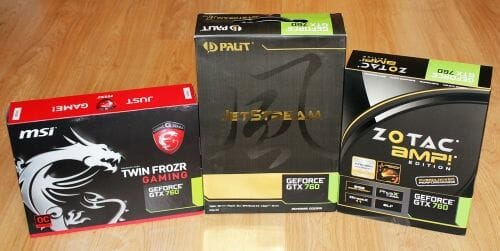
Besides taking a close look at each of them, we will benchmark a GeForce GTX 760 SLI configuration in comparison with a more expensive single card.
Testing Participants
Technical Specifications and Market Positioning
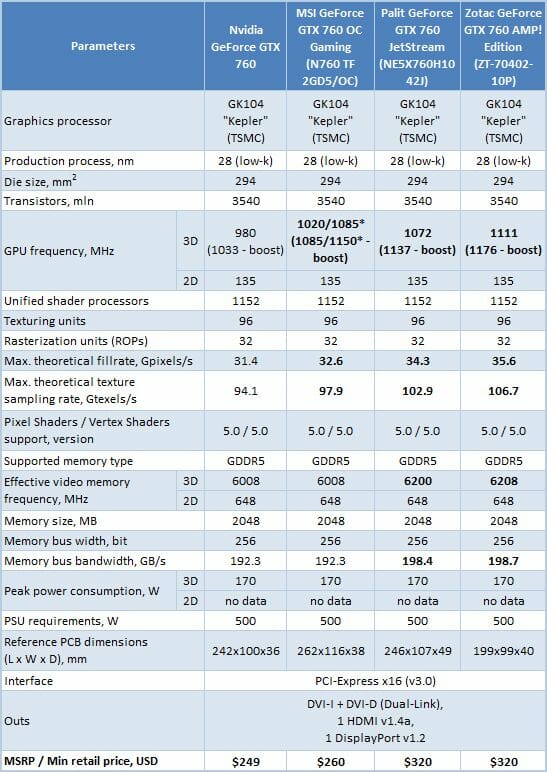
MSI GeForce GTX 760 OC Gaming 2GB (N760 TF 2GD5/OC)
MSI’s Gaming series products all feature eye-catching packaging. The N760 TF 2GD5/OC model we’ve got for our tests is no exception.
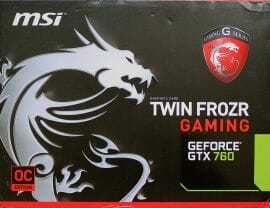
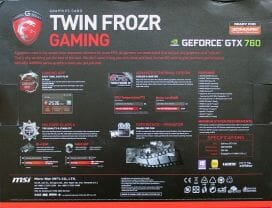
The product features, specifications and minimum system requirements are listed on the back of the packaging. The graphics card is fixed in the middle of the cardboard box you will find under the colorful external wrapper. Above it, there’s a flat box with accessories which include two power adapters, a DVI->D-Sub adapter, a CD with drivers and utilities, and a brief installation guide.
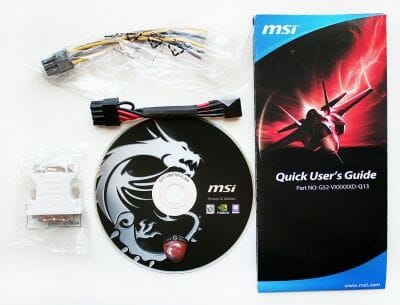
The graphics card is manufactured in China and comes with a 3-year warranty. Interestingly, it is priced at $260, which is not much higher compared to Nvidia’s recommended price, although the MSI version differs a lot from the reference GeForce GTX 760.
The MSI GeForce GTX 760 OC Gaming looks stylish and powerful as its face side is covered with the cooler’s metal casing with two fans. It doesn’t look bulky, though. Its dimensions are 262x116x38 mm.
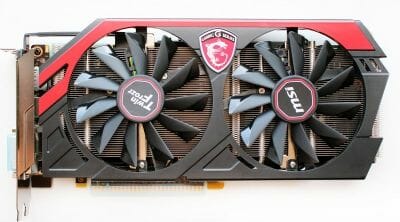
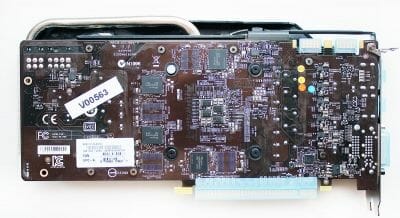
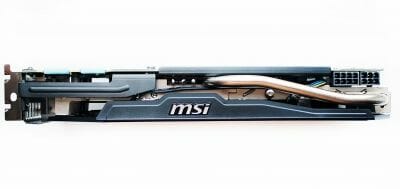
In the top view we can see power connectors and heat pipes piercing the heatsink. The reverse side of the PCB is exposed, revealing memory chips as well as empty spots for more memory chips. There’s a neat plastic cap on each of the card’s connectors.
The MSI GeForce GTX 760 OC Gaming has the following selection of video outputs: dual-link DVI-I and DVI-D ports, one HDMI 1.4a, and one DisplayPort version 1.2.
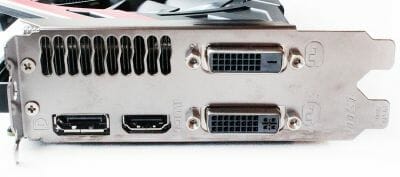
Notwithstanding the cooler type, the vent grid in the card’s mounting bracket does a good job of exhausting the hot air out of the computer case.
The MSI version has the same two SLI connectors as the reference GTX 760 but their power connectors differ:
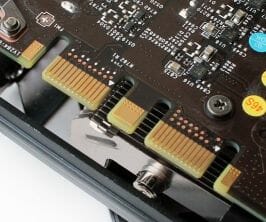
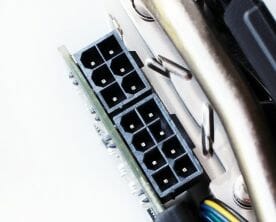
Instead of two 6-pin power connectors, the MSI GeForce GTX 760 OC Gaming has 6-pin and 8-pin ones, implying an improved power system. On the other hand, the peak power draw is specified to be 170 watts as with the reference GeForce GTX 760. By the way, the connectors of power cables turn out to be right under a heat pipe, so while there are no problems with plugging them in, you may find it difficult to take them out afterwards.
Although massive, the cooler is only secured with four screws around the GPU. It is easy to take it off. Underneath it, we found a metal plate that helps reduce the temperature of the power transistors and memory chips.
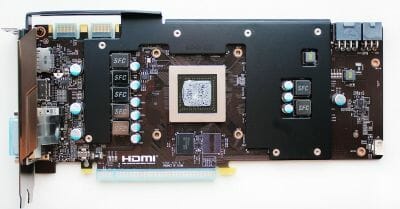
Take note of the card’s stiffness rib, by the way. It will block both SLI connectors if you use stiff connecting bridges, making it impossible to include the card into 3-way SLI configurations (which require connecting bridges of that type). So, you may want to install an MSI GeForce GTX 760 OC Gaming into the bottom/second PCIe x16 slot and another graphics card (not this model from MSI) into the first slot.
We removed the metal plate to check out the card’s PCB design:
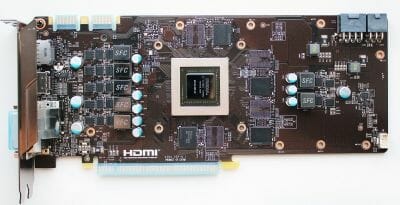
MSI’s custom design features an improved power system and premium Military Class IV components complying with the American military standard MIL-STD-810G. So we can see here aluminum-core solid-state capacitors with ultra-low resistance and 10-year service life, economical Hi-c capacitors, and Super Ferrite Chokes with 10% higher energy efficiency and 30% higher current capacity compared to ordinary chokes.
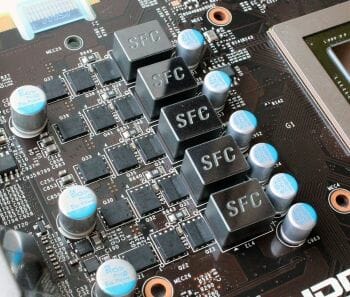
All of this can be had for about the same money as a reference GeForce GTX 760.
The 5-phase GPU voltage regulator is managed by an RT8802A controller from Richtek Technology which is installed on the reverse side of the PCB.
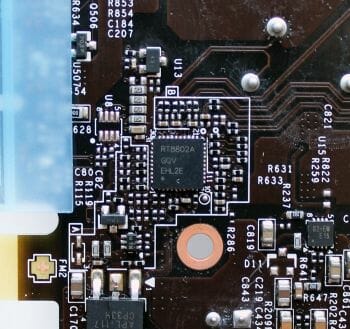
There are two more power phases for the graphics memory and PLL.
The card’s 28nm GK104 chip is revision A2. It was manufactured in Taiwan on the 8th week of 2013 (the end of February).
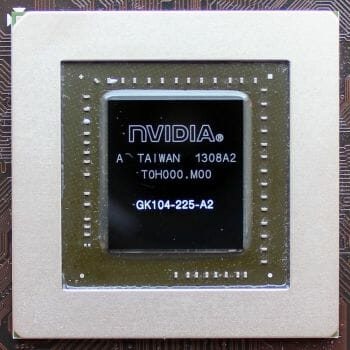
The base GPU clock rate is 1020 MHz in 3D mode. It can be boosted to 1085 MHz. After setting the Power and Temperature Targets are their maximums, the GPU frequency peaked up to 1085 MHz in boost mode, according to our monitoring tools. Besides that, you can use MSI Gaming App to quickly switch the card into one of three available operation modes:
In the OC mode, the GPU works at 1085/1150 MHz, which is quite impressive in comparison with the GPU clock rate of the reference GeForce GTX 760 (980/1033 MHz). The Gaming mode is the default operation mode for the MSI GeForce GTX 760 OC Gaming whereas the Silent Mode brings the clock rates down to the reference card’s. Besides, the GPU clock rate goes down to 135 MHz in 2D applications and the voltage drops from 1.2 to 0.875 volts.
The ASIC quality of the GPU is rather low at 74.2%.
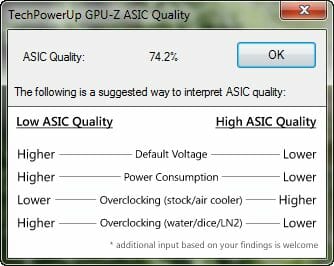
The MSI GeForce GTX 760 OC Gaming carries 2 GB of graphics memory in FCBGA-packaged chips soldered to both sides of its PCB. These are H5GQ2H24AFR R0C chips from Hynix.
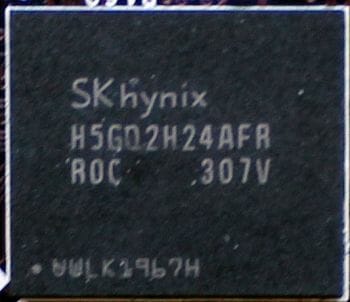
The memory is rated for 6000 MHz and is actually clocked at 6000 MHz on the MSI card. So, there is no factory overclocking in this respect. In 2D applications the memory frequency is lowered to 648 MHz. Thus, the MSI GeForce GTX 760 OC Gaming has the following specs in its default operating mode:
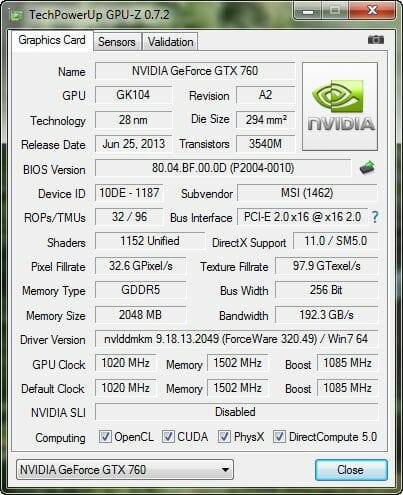
Besides the premium PCB components and pre-overclocked GPU, the MSI GeForce GTX 760 OC Gaming features the exclusive cooler called Twin Frozr IV:
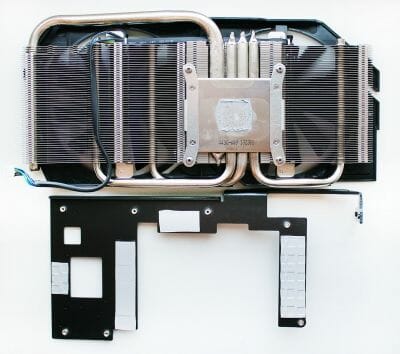
It consists of a large aluminum heatsink with four heat pipes, three of each are 6 mm in diameter. The fourth pipe is 8 mm.
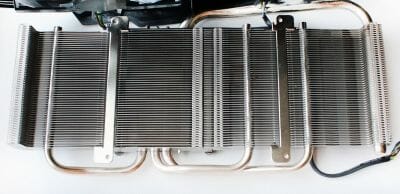
The heatsink is supposed to feature the Airflow Control technology which directs the heat flow towards the heat pipe by means of a special deflector and thus improves the cooler’s performance. We couldn’t find any deflectors in this heatsink, though. The cooler’s heat pipes are referred to as Super Pipes. MSI claims they have twice the heat transfer speed of ordinary heat pipes.
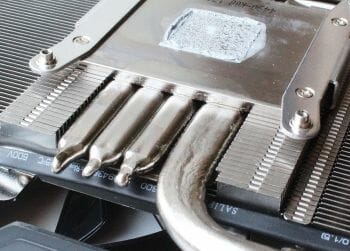
The heat pipes are soldered to the heatsink’s aluminum fins as well as to the nickel-plated copper base. The cooler employs two 100mm PLD10010S12HH fans from Power Logic with Propeller Blade (the slanted blades ensure higher pressure at lower noise) and Dust Removal (temporary backward rotation when shutting down to remove dust) technologies.
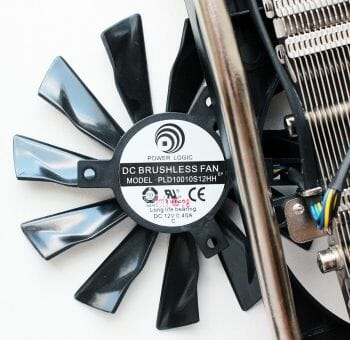
The fans are PWM-regulated in a speed range of 900 to 3000 RPM. They have no highlighting.
Hereinafter, to check out the cards temperatures we used five runs of the pretty resource-hungry Aliens vs. Predator (2010) benchmark at the highest visual quality settings, at a resolution of 2560×1440 pixels. We used 16x anisotropic filtering but no MSAA 4x:
We used MSI Afterburner 3.0.0 beta 10/11 and GPU-Z version 0.7.1/0.7.2 for monitoring of temperatures inside the closed system case, which configuration is discussed in detail in the corresponding chapter of the roundup. All tests were performed at 26°C room temperature.
The Twin Frozr IV cooler amazed us with its performance and noise level. With its fans regulated automatically, the GPU was only 73°C hot. Most impressively, the fans were rotating at 1300 RPM only.
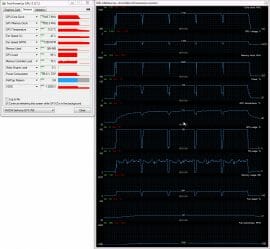
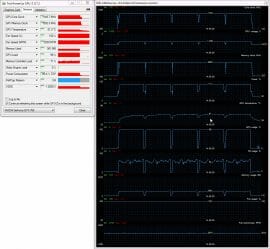
We’ll discuss the noise factor shortly, yet we want to assure you that the MSI GeForce GTX 760 OC Gaming is quite comfortable at that speed of the fans. When the maximum speed of 3000 RPM is set manually, the fans are rather loud, but the peak GPU temperature is 13°C lower at 61°C. The coolers of the other two graphics cards are far less efficient.
The MSI GeForce GTX 760 OC Gaming turned out to have the highest overclocking potential, too. Without changing its GPU voltage, we increased the GPU and memory clock rates by 135 and 1500 MHz, respectively.
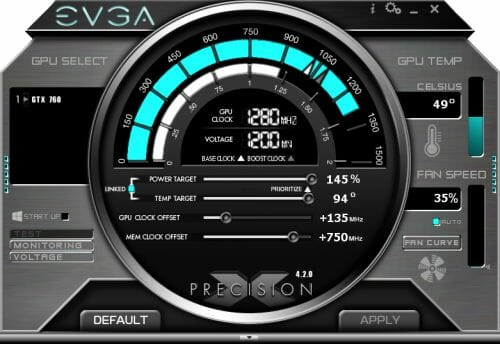
The resulting GPU clock rate was 1155/1220 MHz in 3D applications whereas the graphics memory was stable at 7508 MHz.
The overclocked card grew 6°C hotter but its fans only accelerated by 90 RPM.
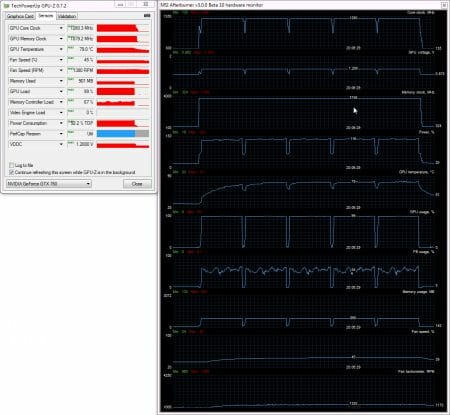
Thus, the MSI GeForce GTX 760 OC Gaming remains comfortable acoustically in 3D applications even when overclocked, which is quite a rare thing for a midrange graphics card. MSI’s cooler is praiseworthy indeed.
Palit GeForce GTX 760 JetStream 2GB (NE5X760H1042J)
Palit Microsystems has released two GeForce GTX 760s: a copy of the reference card and a JetStream model that we’ve got for us to test.
The Palit card comes in the largest box with a gold shimmer on the front and a description of Nvidia’s technologies on the back.
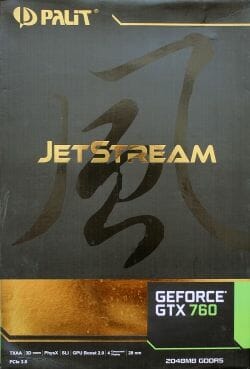
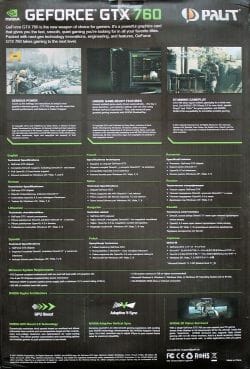
You can also unfold the box to read some information about the graphics card itself and take a look at its cooler through a plastic window.
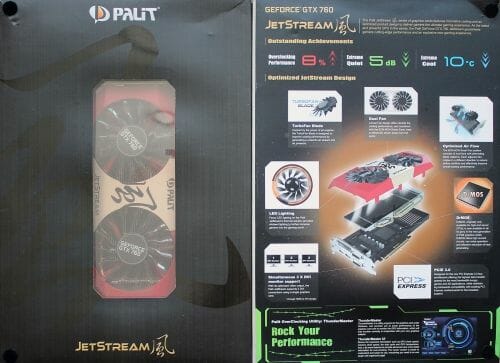
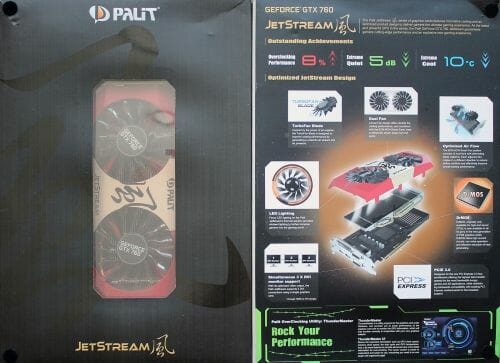
Besides detailed product features, there are numbers here that show the advantage of the Palit version over the reference card. Particularly, the GeForce GTX 760 JetStream is going to have 8% higher overclocking potential, 5 dB lower noise level, and 10°C lower temperature. A brief description of the overclocking tool ThunderMaster is given at the bottom.
The accessories include a power adapter, a digital-to-analog video adapter, a software CD, an installation guide and a sticker with a hieroglyph.
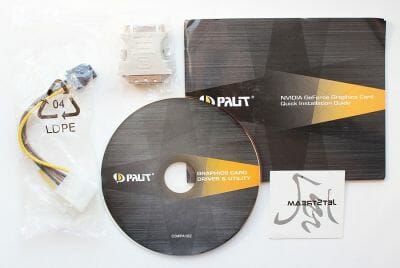
The Palit GeForce GTX 760 JetStream is manufactured in China and costs $320, which is considerably more expensive than Nvidia’s recommended price. The above-discussed MSI is cheaper, too. The warranty is 2 years.
The card is very beautiful. The red-and-gold plastic casing shows the manufacturer name and the product series.
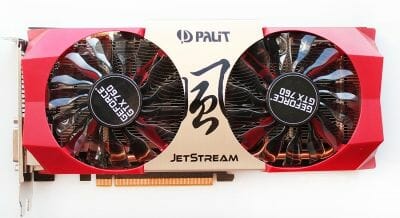
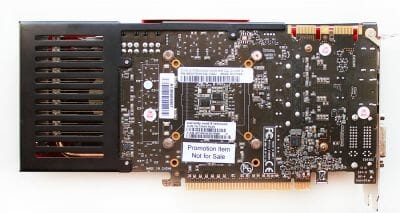
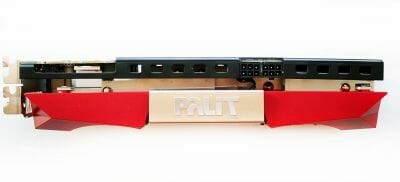
There’s a plastic extension to the PCB to make the latter as long as the cooler. The PCB itself is short. The card measures 246x107x49 mm.
The Palit is no different from the reference sample in terms of video outputs and other connectors:
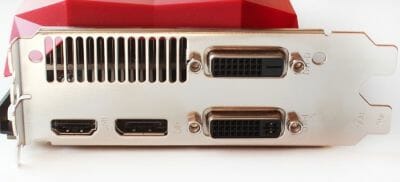
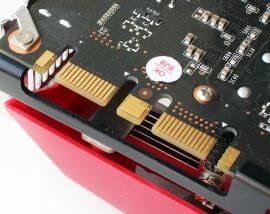
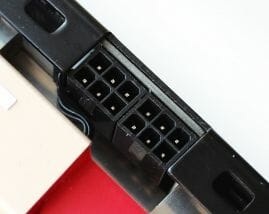
There is a broad aluminum heatsink on the card’s power components. The memory chips are only cooled by the air flow from the fans.
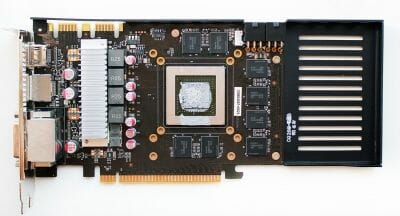
The power system follows the standard 4+2+1 formula (GPU+memory+PLL).
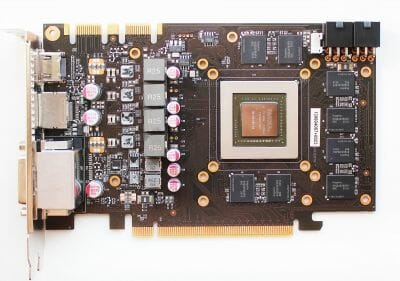
The Palit GeForce GTX 760 JetStream features DrMOS transistors with improved characteristics.
The GPU voltage regulator is managed by an ON Semiconductor NCP5392E controller located on the reverse side of the PCB.
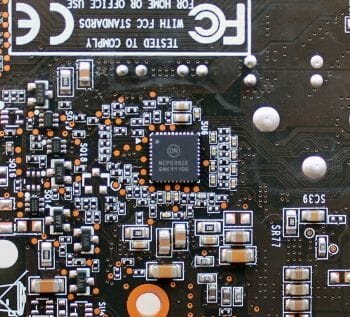
The GPU of the Palit card is revision A2, too. It was manufactured 1 week later than the MSI card’s GPU.
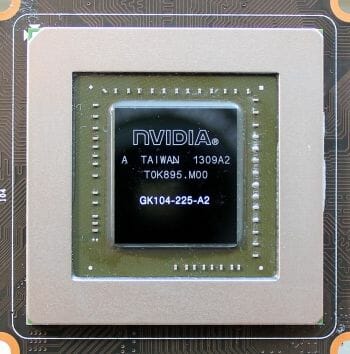
Its 3D frequency is pre-overclocked to 1072/1137 MHz (+9% to the reference card’s GPU clock rate). The ASIC quality of the chip is 76.6%.
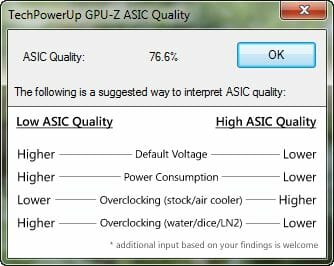
There are 2 GB of memory in eight chips on the face side of the PCB:
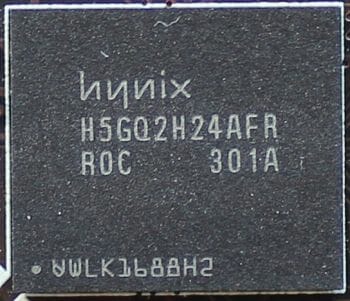
These are the same Hynix H5GQ2H24AFR R0C chips rated for 6000 MHz but, as opposed to the MSI, the Palit has a memory frequency of 6200 MHz.
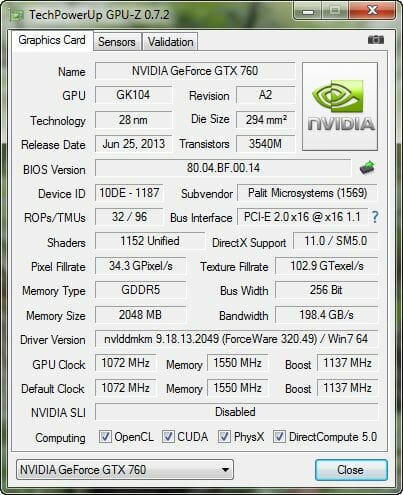
The Palit GeForce GTX 760 JetStream has a rather simple cooler, yet it seems to be quite efficient.
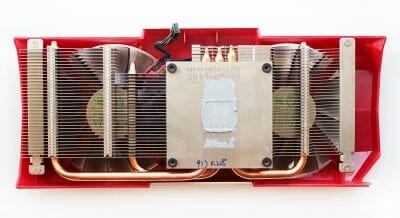
The heatsink consists of thin aluminum fins and has three copper heat pipes, 8 mm in diameter. The pipes are soldered to the cooler’s base and heatsink fins.
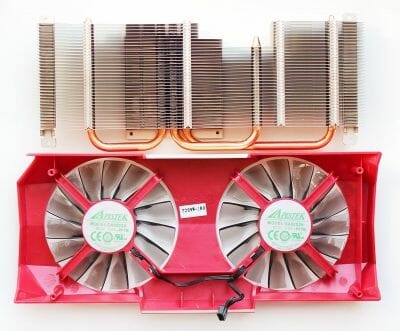
The heatsink is covered with a plastic casing with two 92mm fans that have translucent impellers.
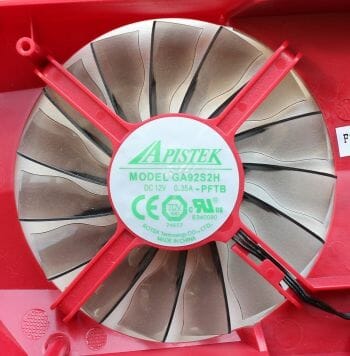
The fans are PWM-regulated in a speed range of 800 to 2800 RPM and feature white highlighting.
The Palit’s cooler is inferior to the MSI’s in terms of efficiency, yet copes with its job well enough. With its fan regulated automatically, the GPU was 79°C hot and the fans were rotating at 1740 RPM.
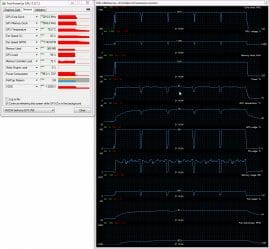
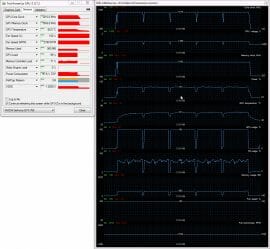
At the maximum speed of 2760 RPM, the peak GPU temperature was 69°C, so the Palit cooler is quite sufficient.
The overclocking potential of this sample was poor. We only managed to overclock the GPU and memory by 35 and 620 MHz, respectively.
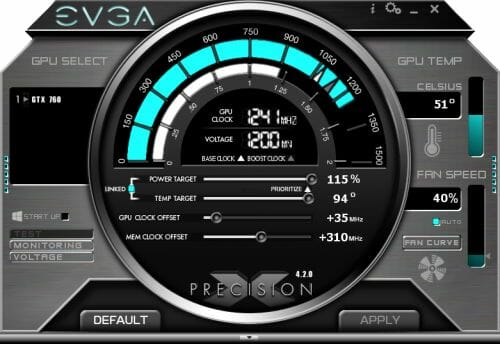
The overclocked Palit worked at 1107/1172/6820 MHz:
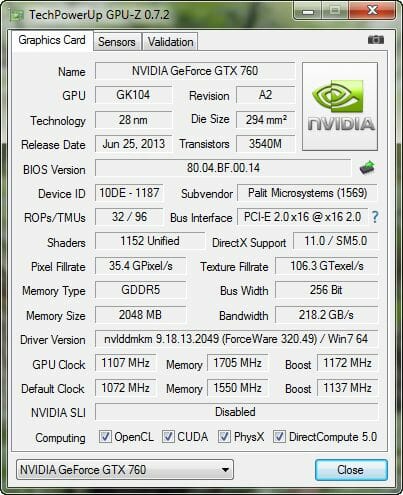
The GPU got 1°C hotter when overclocked whereas the fans didn’t change their speed at all.
ZOTAC GeForce GTX 760 AMP! Edition 2GB (ZT-70402-10P)
Zotac offers two GeForce GTX 760 models: a copy of the reference card and the AMP! Edition model that we’re going to test today. Its packaging follows Zotac’s traditional style:
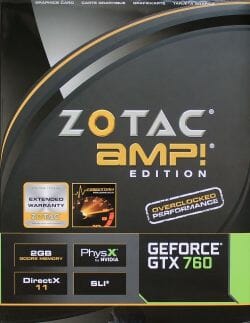
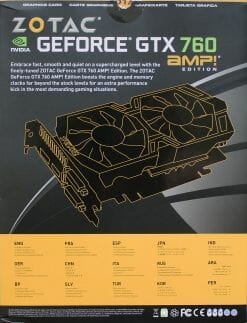
There’s not much information on the sides of the box, yet you can learn there any basic facts you want to know. The graphics card is in the middle of the box on a polyethylene-foam tray. The following accessories can be found in the bottom compartment:
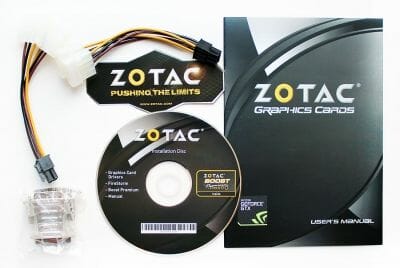
There are two power adapters among the accessories although you usually get only one with most graphics cards.
The Zotac GeForce GTX 760 AMP! Edition is manufactured in China and costs $320. The price covers the extended 5-year warranty as well.
The card is easily recognizable as a Zotac product. Its face side is covered by the cooler which has a metal casing and two orange fans.
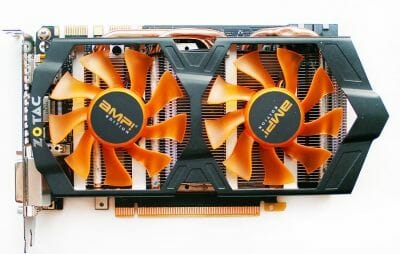
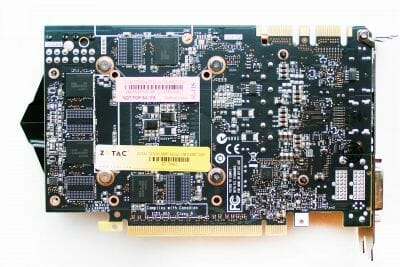
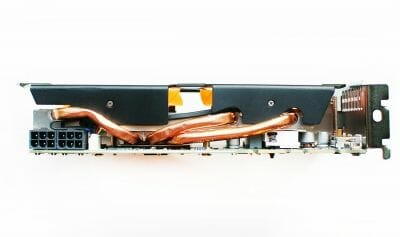
The reverse side of the PCB is exposed and we can see three heat pipes at the top. The card is the smallest in this review at 199x99x40 mm.
The GeForce GTX 760 AMP! Edition has a standard set of video outputs, but the DVI connectors differ in color. There are additional vents in its mounting bracket:
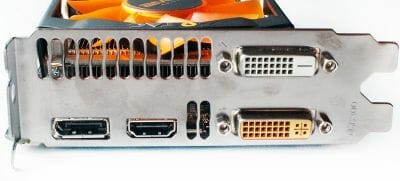
The power and SLI connectors are perfectly standard:
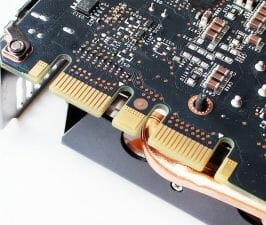
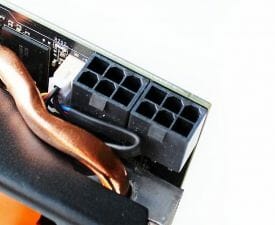
The PCB is a copy of the reference one.
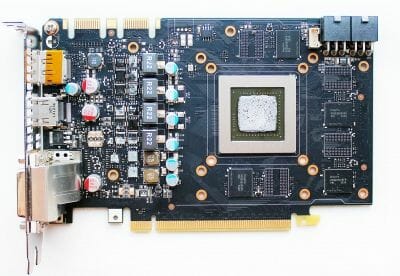
Surprisingly, the AMP! Edition card, which is actually the fastest GeForce GTX 760 available, uses the PCB design suggested by Nvidia. Even the power system controller is the same ON Semiconductor NCP5392P:
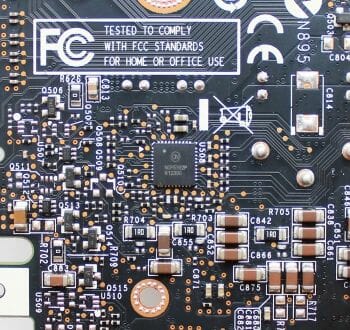
The GPU was manufactured on the 49th week of 2012 (in early December). It is revision A2, just like the others.
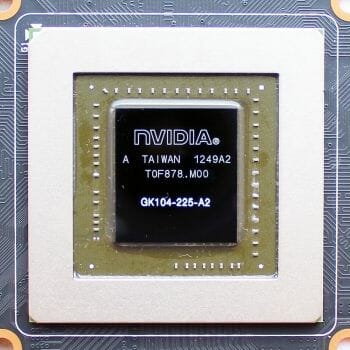
The Zotac has the fastest GPU: 1111 MHz in 3D mode (boostable to 1176 MHz). The ASIC quality of the chip is 74.4%.
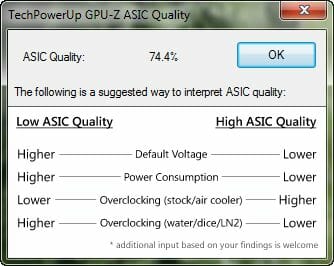
The Zotac comes with the same memory chips from Hynix as we’ve seen on the MSI and Palit cards:
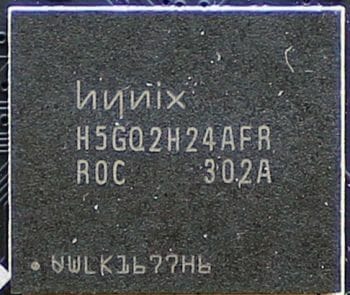
Their clock rate is increased by 3.5% in 3D mode to 6208 MHz. In 2D mode the clock rate is reduced to 648 MHz. The peak memory bandwidth over the 256-bit bus is 198.7 GB/s.
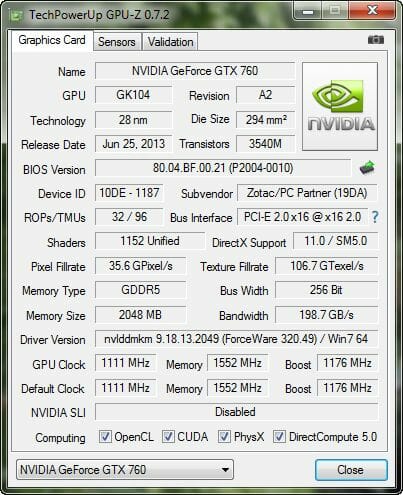
The Zotac GeForce GTX 760 AMP! Edition is equipped with the Dual Silencer cooler which is accompanied by a small aluminum heatsink on the power system components.
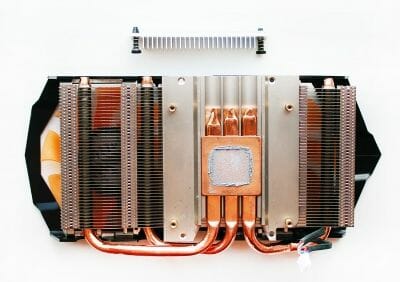
Three 6mm heat pipes are soldered to the copper base and pierce the slim aluminum fins of the heatsink. The pipes are flattened in the base. An aluminum plate with cooler’s fasteners is soldered to them from above.
The cooler has two 80mm fans with curved blades:
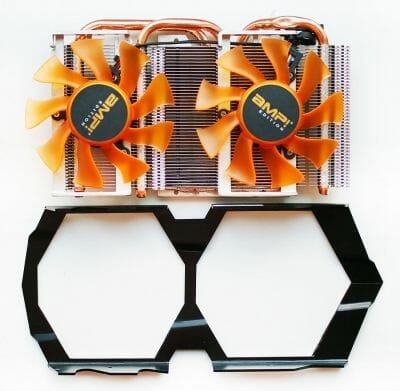
These are PWM-regulated FD8015U12S fans from FirstD.
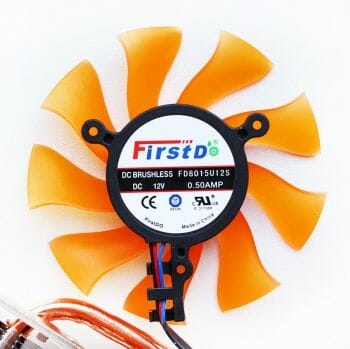
According to our monitoring tools, the speed of the fans varies from 1300 to 3600 RPM. Compared to the two coolers discussed above, the Dual Silencer is far from efficient. In the automatic regulation mode the fans worked at 2880 RPM, but the GPU grew as hot as 88°C anyway.
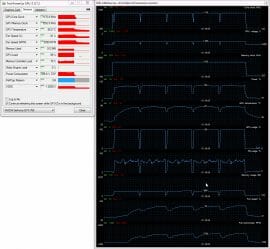
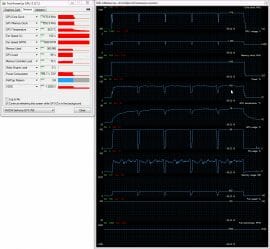
This is 10°C worse in comparison with the Palit and 15°C worse in comparison with the MSI. At the maximum speed of the fans (3600 RPM) the GPU was 80°C hot but the cooler was very noisy.
Notwithstanding the high default frequency, the GPU of the Zotac GeForce GTX 760 AMP! Edition could be overclocked by an additional 100 MHz. We also overclocked the graphics memory by 800 MHz.
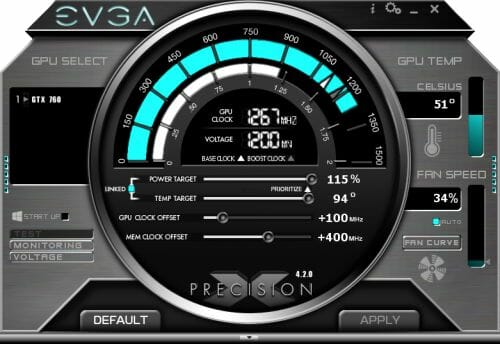
So the resulting clock rates were 1211/1276/7008 MHz.
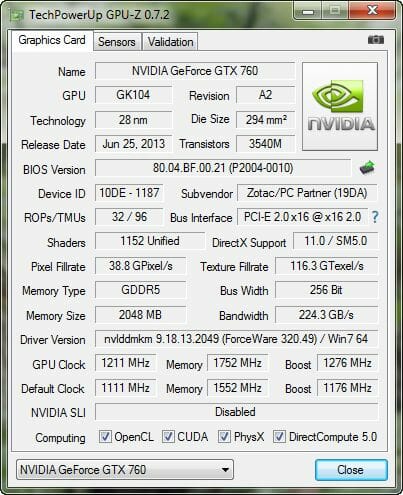
The overclocked Zotac was very hot and noisy. The GPU temperature grew to 90°C while the fans rotated at 3180 RPM.
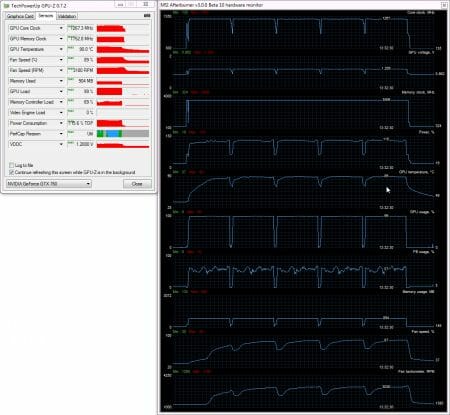
We guess Zotac’s engineers should think about improving the cooler as well as the PCB. We are not at all sure the card can last for long at such high temperatures. And of course, there’s no talking about acoustic comfort.
Noise Level, Temperature and Power Consumption
The noise level of each cooler was measured between 1:00 and 3:00 AM in a closed room about 20 m2 big using CENTER-321 electronic noise meter. The noise level for each cooler was tested outside the system case when the only noise sources in the lab were the cooler and its fan. The noise meter was installed on a tripod and was always at a 150 mm distance from the cooler fan rotor. The tested cooling systems were placed at the edge of the desk on a sheet of polyurethane foam. The lowest noise reading our noise meter device can register is 29.8 dBA and the subjectively comfortable noise level in these testing conditions was around 36 dBA (do not mix it up with low noise level). The fan(s) rotation speed was adjusted in the entire supported range using our precise in-house controller by changing the voltage with 0.5 V increment.
The vertical dotted lines show the peak speed of the coolers’ fans in the automatic regulation mode. Let’s take a look at the results:
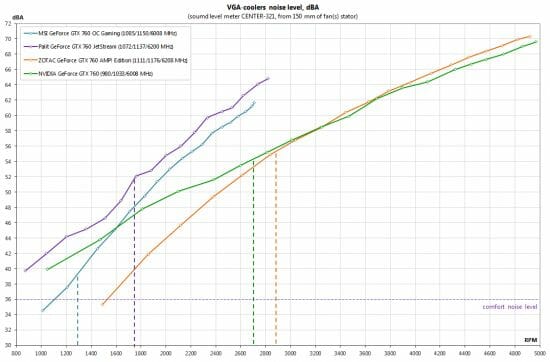

We’ve got a clear winner in terms of noise level – the GeForce GTX 760 OC Gaming from MSI. It is the closest to the comfortable level and, subjectively, silent inside a computer case. The remaining three cards from Palit, Zotac and Nvidia are comparable in terms of noisiness in the automatic fan regulation mode and are all rather loud in 3D mode.
The following diagram shows the noise level of the cards in the automatic fan regulation mode and at the maximum speed of the fan and also shows the peak GPU temperature. The GPU clock rates during the test are indicated in the product names. The graphics cards are sorted in the order of ascending GPU temperature:
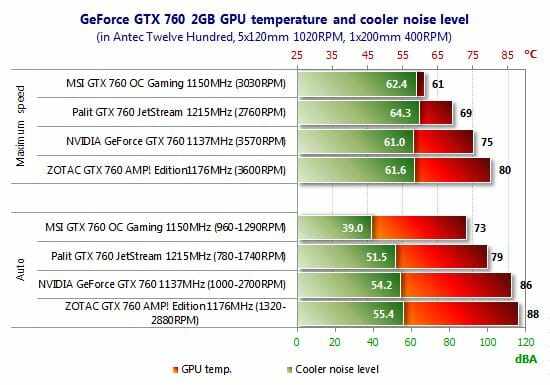
The MSI GeForce GTX 760 OC Gaming wins both test modes again. It is followed by the Palit, which in its turn is much better in temperature and noisiness than the cards from Zotac and Nvidia. We can also note that the graphics cards are comparable in terms of noise level at the maximum speed of the fans but the temperatures differ a lot. Somewhat unexpectedly, the Zotac is inferior to the reference card from Nvidia. On the other hand, the Zotac has the highest clock rates by default.
The standings do not change when the cards are overclocked (in the automatic fan regulation mode):
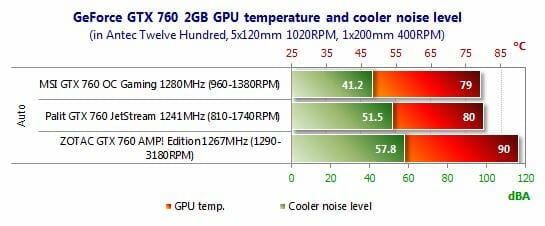
Being inferior to the MSI in noisiness, the Palit is very close to it in temperature. The Zotac shouldn’t be overclocked at all considering the high temperature.
We measured the power consumption of our testbed equipped with different graphics cards using a multifunctional Zalman ZM-MFC3 panel which can report how much power a computer (without the monitor) draws from a wall outlet. There were two test modes: 2D (editing documents in Microsoft Word or web surfing) and 3D. In the latter case the load was created by four runs of the introductory “Swamp” scene in Crysis 3 game at 2560×1440 with maximum image quality settings, but without MSAA.
Besides configurations with three original GeForce GTX 760s, we also measured the power consumption of a 2-way SLI tandem and an MSI GeForce GTX 780 OC Gaming card (we’ll use the latter in our performance tests).
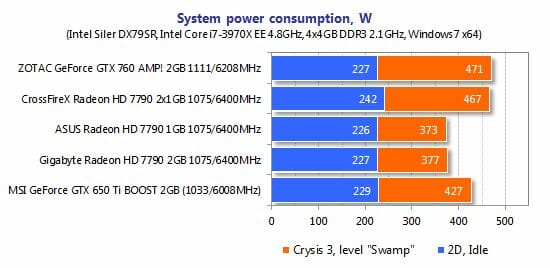
The configurations with original GeForce GTX 760s differ but little in terms of power consumption, yet we can note that the MSI one is the most economical, also in 2D mode. Next goes the Palit GeForce GTX 760 JetStream and the Nvidia GeForce GTX 760. The high clock rates of the Zotac card increase the power draw by 15 watts, which isn’t much. The 2-way SLI tandem built out of two GeForce GTX 760s needs 150 watts more. The number is close to the specified power consumption of the reference GeForce GTX 760, but even in this case a 650-700W PSU is going to be enough.
Testbed Configuration and Testing Methodology
All participating graphics cards were tested in a system with the following configuration:
- Mainboard: Intel Siler DX79SI (Intel X79 Express, LGA 2011, BIOS 0559 from 03/05/2013);
- CPU: Intel Core i7-3970X Extreme Edition, 3.5/4.0 GHz (Sandy Bridge-E, C2, 1.1 V, 2 x 256 KB L2, 15 MB L3);
- CPU cooler: Phanteks PH-TC14PE (2 x Corsair AF140 fans at 900 RPM);
- Thermal interface: ARCTIC MX-4;
- Graphics cards:
- MSI GeForce GTX 780 OC Gaming 3 GB (N780 TF 3GD5/OC, 954/1006/6008 MHz);
- Palit GeForce GTX 760 JetStream 2 GB (NE5X760H1042J, 1111/1176/6208 MHz);
- Zotac GeForce GTX 760 AMP! Edition 2 GB (ZT-70402-10P, 1111/1176/6208 MHz);
- Nvidia GeForce GTX 760 2 GB (980/1033/6008 MHz).
- System memory: DDR3 4 x 8 GB G.Skill TridentX F3-2133C9Q-32GTX: 2133 MHz / 9-11-11-31 / 1.6 V;
- System drive: Crucial m4 256 GB SSD (SATA-III,CT256M4SSD2, BIOS v0009);
- Drive for programs and games: Western Digital VelociRaptor (300GB, SATA-II, 10000 RPM, 16MB cache, NCQ) inside Scythe Quiet Drive 3.5” HDD silencer and cooler;
- Backup drive: Samsung Ecogreen F4 HD204UI (SATA-II, 2 TB, 5400 RPM, 32 MB, NCQ);
- System case: Antec Twelve Hundred (front panel: three Noiseblocker NB-Multiframe S-Series MF12-S2 fans at 1020 RPM; back panel: two Noiseblocker NB-BlackSilentPRO PL-1 fans at 1020 RPM; top panel: standard 200 mm fan at 400 RPM);
- Control and monitoring panel: Zalman ZM-MFC3;
- Power supply: Corsair AX1200i 1200 W (with a default 120 mm fan);
- Monitor: 27” Samsung S27A850D (DVI-I, 2560×1440, 60 Hz).
For our 2-way SLI tests we used the cards from Palit and Zotac after increasing the clock frequencies of the former to the level of the latter:
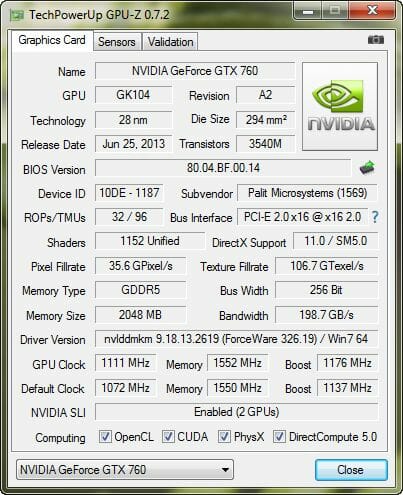
We are going to compare the performance of the overclocked tandem against the factory overclocked MSI GeForce GTX 780 OC Gaming 3 GB graphics card, and the performance advantage demonstrated by the fastest GeForce GTX 760 will be estimated against that of the reference card:
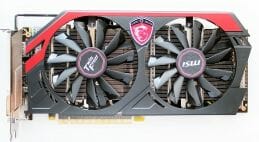
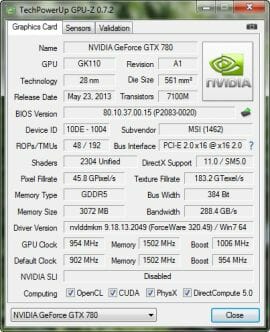
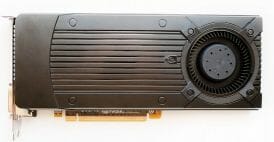
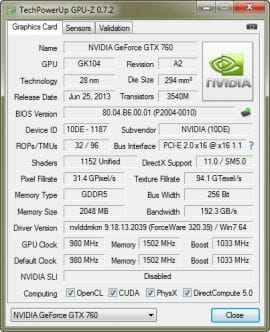
In order to lower the dependence of the graphics cards performance on the overall platform speed, I overclocked our 32 nm six-core CPU with the multiplier set at 48x, BCLK frequency set at 100 MHz and “Load-Line Calibration” enabled to 4.8 GHz. The processor Vcore was increased to 1.38 V in the mainboard BIOS:
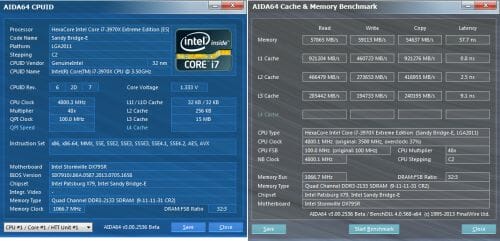
Hyper-Threading technology was enabled. 32 GB of system DDR3 memory worked at 2.133 GHz frequency with 9-11-11-31 timings and 1.6V voltage.
The test session started on July 19, 2013. All tests were performed in Microsoft Windows 7 Ultimate x64 SP1 with all critical updates as of that date and the following drivers:
- Intel Chipset Drivers 9.4.0.1017 WHQL from 03/27/2013 for the mainboard chipset;
- DirectX End-User Runtimes libraries from November 30, 2010;
- Nvidia GeForce 326.19 beta driver for Nvidia based graphics cards;
- AMD Catalyst 13.6 beta 2 driver from 06/04/2013 + Catalyst Application Profiles 13.5 (CAP1) for AMD based graphics cards.
We tested the graphics cards performance in two resolutions: 1920×1080 and 2560×1440. The tests were performed in two image quality modes: “Quality+AF16x” – default texturing quality in the drivers with enabled 16x anisotropic filtering and “Quality+ AF16x+MSAA 4x(8x)” with enabled 16x anisotropic filtering and full screen 4x or 8x antialiasing, in those cases when the average fps rate remained high enough for comfortable gaming experience. We enabled anisotropic filtering and full-screen anti-aliasing from the game settings. If the corresponding options were missing, we changed these settings in the Control Panels of Catalyst and GeForce drivers. We also disabled Vsync there. There were no other changes in the driver settings.
This time we are going to drop the old Metro 2033: The Last Refuge game from the list of benchmarks, since the new Metro: Last Light has already stepped in to completely replace it and has been updated to version 1.0.5. A few other games have also been updated. Now our benchmarking suite includes two popular semi-synthetic benchmarks and 11 resource-consuming games of various genres:
- 3DMark 2013 (DirectX 9/11) – version 1.0, benchmarks in “Cloud Gate”, “Fire Strike” and “Fire Strike Extreme” scenes;
- Unigine Valley Bench (DirectX 11) – version 1.0, maximum image quality settings, AF16x and(or) MSAA 4x, 1980×1080 resolution;
- Total War: Shogun 2: Fall of the Samurai (DirectX 11) – version 1.1.0, built-in benchmark (Sekigahara battle) at maximum graphics quality settings and enabled MSAA 8x in one of the test modes;
- Battlefield 3 (DirectX 11) – version 1.4, all image quality settings set to “Ultra”, two successive runs of a scripted scene from the beginning of the “Going Hunting” mission 110 seconds long;
- Sniper Elite V2 Benchmark (DirectX 11) – version 1.05, we used Adrenaline Sniper Elite V2 Benchmark Tool v1.0.0.2 BETA with maximum graphics quality settings (“Ultra” profile), Advanced Shadows: HIGH, Ambient Occlusion: ON, Stereo 3D: OFF, two sequential test runs;
- Sleeping Dogs (DirectX 11) – version 1.5, we used Adrenaline Sleeping Dogs Benchmark Tool v1.0.2.1 with maximum image quality settings, Hi-Res Textures pack installed, FPS Limiter and V-Sync disabled, two consecutive runs of the built-in benchmark with quality antialiasing at Normal and Extreme levels;
- Hitman: Absolution (DirectX 11) – version 1.0.446.0, built-in test with Ultra image quality settings, with enabled tessellation, FXAA and global lighting;
- Crysis 3 (DirectX 11) – version 1.2.0.1000, all graphics quality settings at maximum, Motion Blur amount – Medium, lens flares – on, FXAA and MSAA4x modes enabled, two consecutive runs of a scripted scene from the beginning of the “Swamp” mission 110 seconds long;
- Tomb Raider (2013) (DirectX 11) – version 1.1.743.0, we used Adrenaline Benchmark Tool, all image quality settings set to “Ultra”, V-Sync disabled, FXAA and 2x SSAA antialiasing enabled, TessFX technology activated, two consecutive runs of the benchmark built into the game;
- BioShock Infinite (DirectX 11) – version 1.1.21.65455, we used Adrenaline Action Benchmark Tool v1.0.2.1, two consecutive runs of the built-in benchmark with “Ultra” and “Ultra+DOF” quality settings;
- Metro: Last Light (DirectX 11) – version 1.0.5, we used built-in benchmark for two consecutive runs of the D6 scene. All image quality and tessellation settings were at “Very High”, “Advanced PhysX technology was enabled, we tested with and without SSAA antialiasing;
- GRID 2 (DirectX 11) – version 1.0.82.8704, we used built-in benchmark, graphics image quality settings were at their maximum in all aspects, the tests were run with and without MSAA 8x antialiasing with eight cars on the Chicago track;
- Company of Heroes 2 beta (DirectX 11) – version 3.0.0.9804, two consecutive runs of the integrated benchmark at maximum image quality and physics effects settings.
If the game allowed recording the minimal fps readings, they were also added to the charts. We ran each game test or benchmark twice and took the best result for the diagrams, but only if the difference between them didn’t exceed 1%. If it did exceed 1%, we ran the tests at least one more time to achieve repeatability of results.
Performance
3DMark 2013
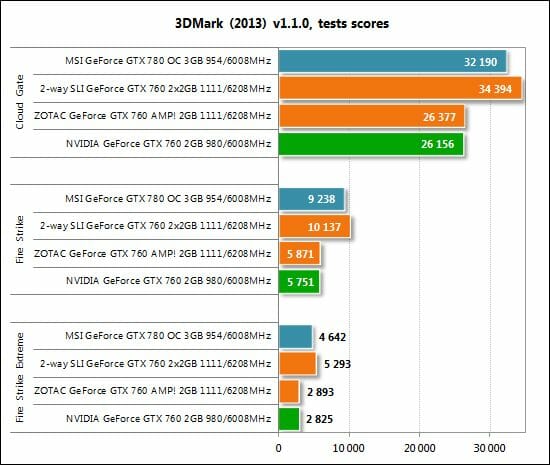
The two GeForce GTX 760s in 2-way SLI mode easily beat the single GeForce GTX 780 in each of the three test scenes. The overclocked Zotac is hardly any faster than the reference GeForce GTX 760 although the difference in their frequencies is quite large (+13.4%). The next benchmark, Unigine Valley, shows the same picture.
Unigine Valley Bench
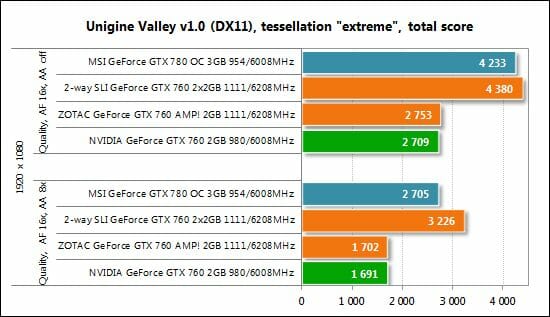
Total War: SHOGUN 2 – Fall of the Samurai
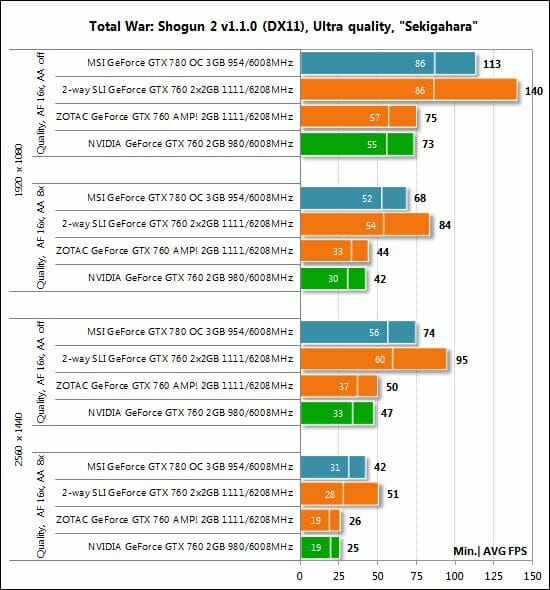
The GeForce GTX 780 is just routed by the cheaper SLI tandem built out of two GeForce GTX 760s: the gap is 21% and more! The SLI configuration has high bottom speed, so the game runs smoothly on it. Its efficiency is over 90% compared to the single GTX 760, reaching 96% at the hardest settings. As for the Zotac GeForce GTX 760 AMP! Edition, it is 3 to 6% faster than the reference GeForce GTX 760.
Battlefield 3
We have almost the same results in Battlefield 3 as in Total War: Shogun 2:
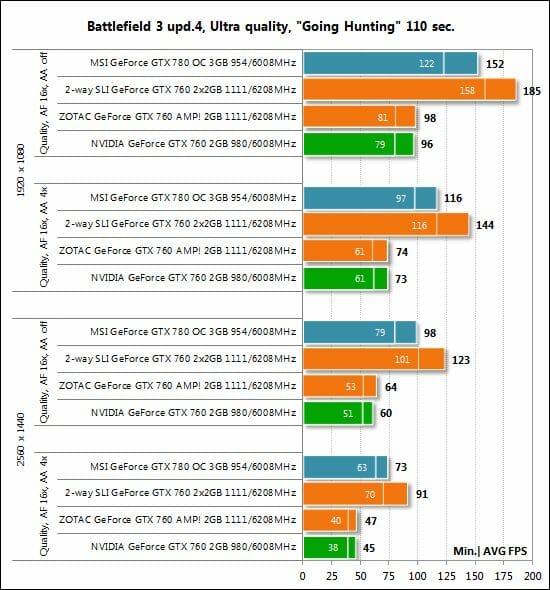
Sniper Elite V2 Benchmark
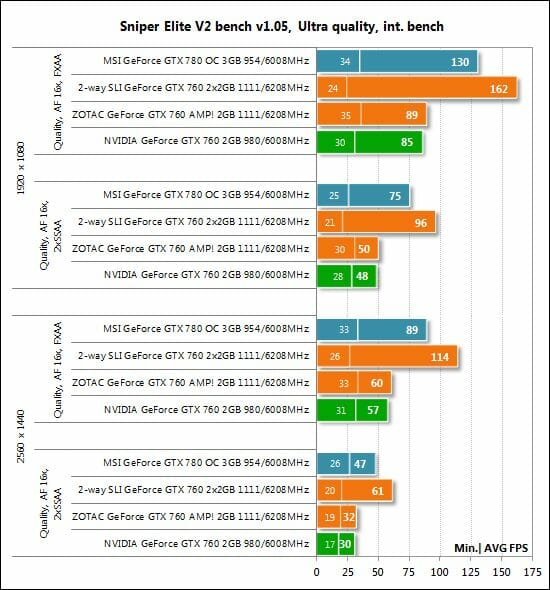
We’d praise the performance of the 2-way SLI tandem in Sniper Elite V2 if it were not for the rather low bottom speed. As for the average frame rate, the two GeForce GTX 760s are 82-92% faster than the single such card and outperform the GeForce GTX 780 by 25-30%. The Zotac is 4 to 7% faster than the Nvidia.
Sleeping Dogs
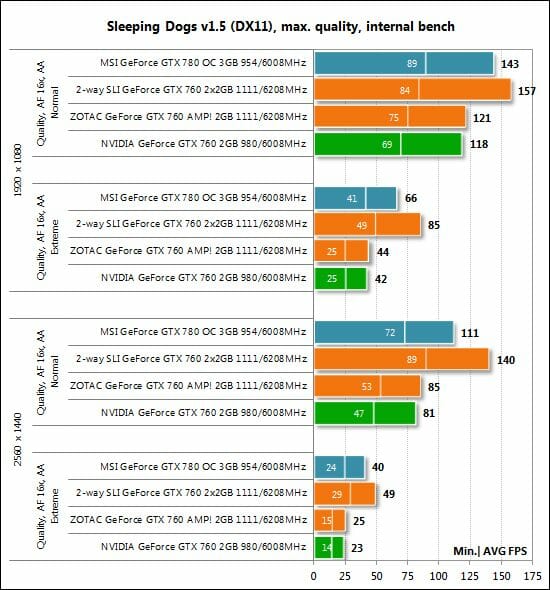
Sleeping Dogs isn’t a problem for modern graphics cards, so its speed depends on the performance of the whole platform. This is indicated by the efficiency of the 2-way SLI tandem, which is as high as 93-96% with 8x MSAA and only 30-66% without 8x MSAA. Anyway, the GeForce GTX 760 SLI configuration is always ahead of the GeForce GTX 780 and offers high bottom speed.
Hitman: Absolution
This benchmark is even more CPU-dependent:
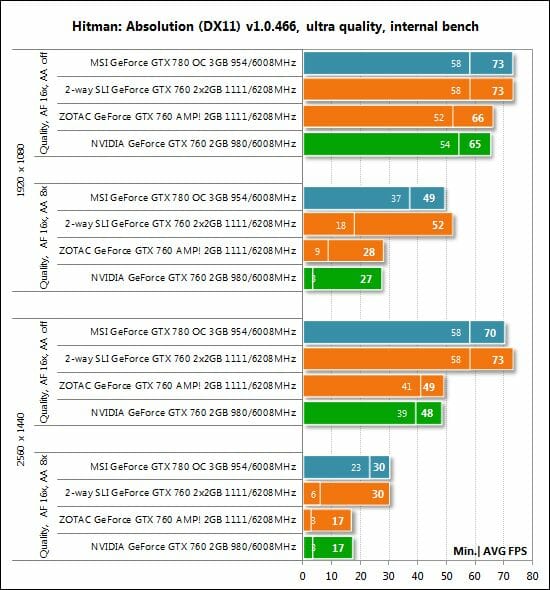
It is only with 8x antialiasing that we can appreciate Nvidia’s multi-GPU technology here, and Hitman: Absolution is the first game so far where the GeForce GTX 760 tandem is no faster than the single GeForce GTX 780. Besides, we can note that the pre-overclocked Zotac is but slightly faster than the reference GeForce GTX 760.
Crysis 3
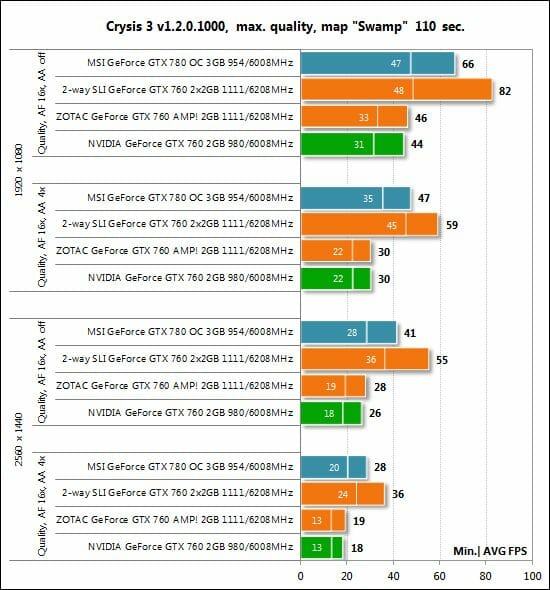
The 2-way SLI configuration is good in Crysis 3, enjoying 90% and higher efficiency. So it easily beats the GeForce GTX 780 by 24 to 34%. The bottom speed goes up along with the average frame rate, so the game runs very smoothly. Crysis 3 is just perfect for SLI technology.
Tomb Raider (2013)
We have the same situation in Tomb Raider:
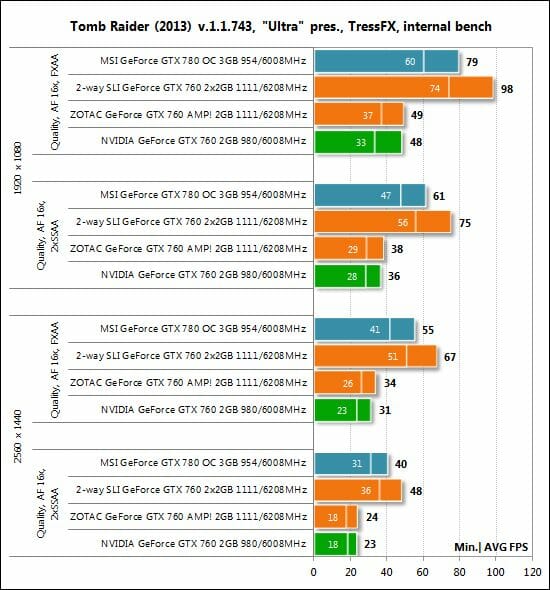
BioShock Infinite
Every graphics card has certain problems with the bottom speed in BioShock Infinite, so it must be due to the game engine or test scene. It doesn’t seem to be a hardware problem.
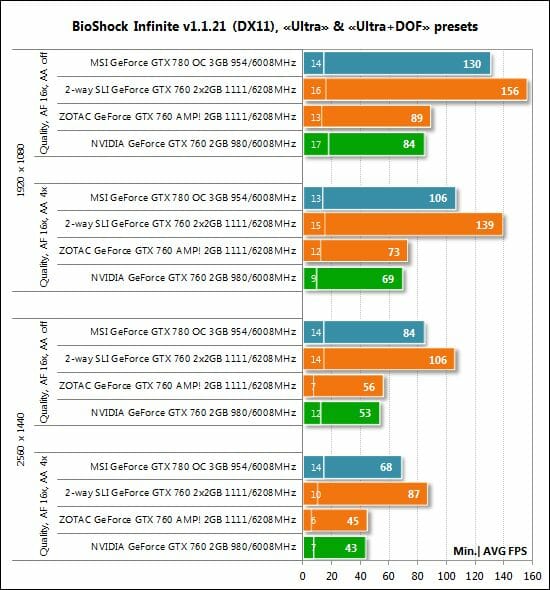
As for average frame rate, the SLI technology is 75 to 93% efficient, making the GeForce GTX 760 tandem much faster than the GeForce GTX 780.
Metro: Last Light
Nvidia’s SLI technology doesn’t work smoothly in this game yet, but the two GeForce GTX 760s are anyway ahead of the single GeForce GTX 780 both with Advanced PhysX…
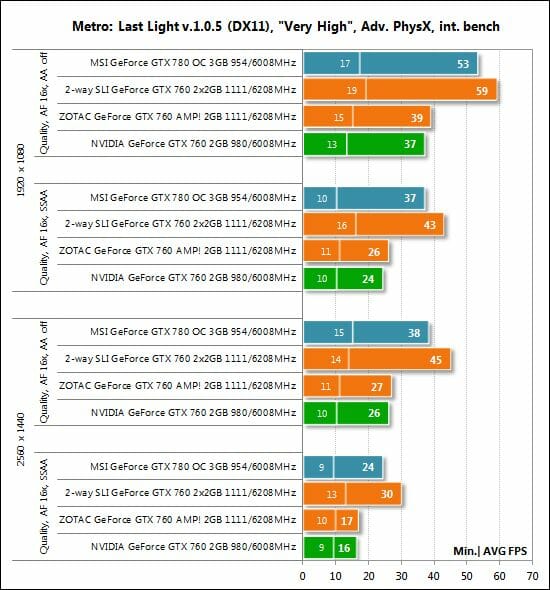
…and when Advanced PhysX is disabled:
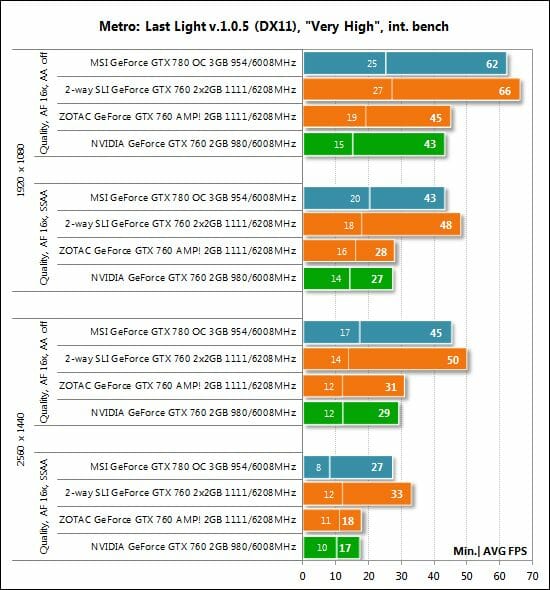
GRID 2
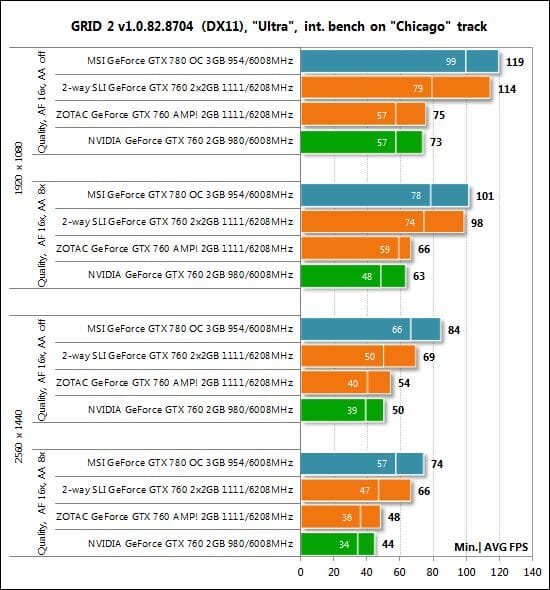
Notwithstanding the newest drivers and game updates, the 2-way SLI tandem is only 28 to 52% faster than the single GeForce GTX 760, so the GeForce GTX 780 remains unbeaten. Still, we can notice certain improvements in this game even compared to our previous test session.
Company of Heroes 2
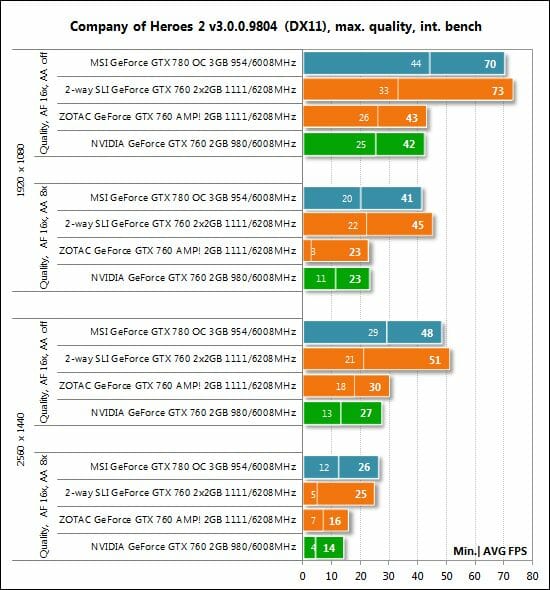
This game had also been updated before our tests. The 2-way GeForce GTX 760 SLI configuration beats the single GeForce GTX 780 in three out of the four test modes.
We had to choose the AFR2 mode in the driver’s control panel to enable SLI in this game. Otherwise, there was no performance boost at all.
Performance Summary Diagrams
Here is a table with full test results, so we can proceed to our summary charts:
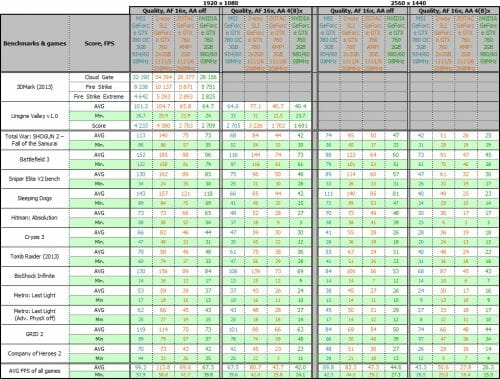
First of all, let’s check out the difference between the pre-overclocked Zotac GeForce GTX 760 AMP! Edition and the reference Nvidia GeForce GTX 760:
Pre-overclocked to 1111/1176/6208 MHz, the Zotac is 3-4% ahead of the Nvidia at 1920×1080 and 6-7% ahead at 2560×1440. The difference is small and far from linear (the Zotac’s GPU and memory clock rates are higher by 13.4% and 3%, respectively).
The following diagrams show the efficiency of the SLI technology as applied to two GeForce GTX 760s:
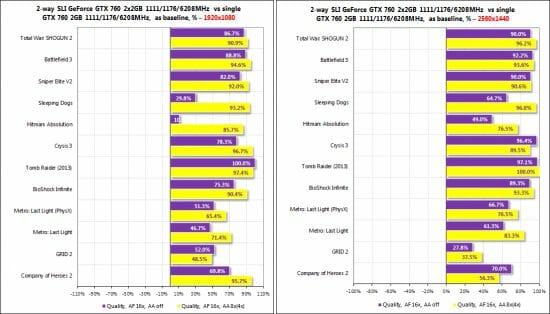
It’s good that the SLI tandem is always faster than the single card, but the SLI technology has low efficiency in the CPU-dependent modes of Sleeping Dogs and Hitman: Absolution as well as in the new GRID 2. In the majority of the remaining games Nvidia’s multi-GPU technology works very well, with fewer problems concerning the bottom speed. It ensures a performance boost of 64 to 85% at 1920×1080 and 75-82% at 2560×1440.
Now the most interesting comparison is a 2-way GeForce GTX 760 SLI configuration vs. a single GeForce GTX 780:
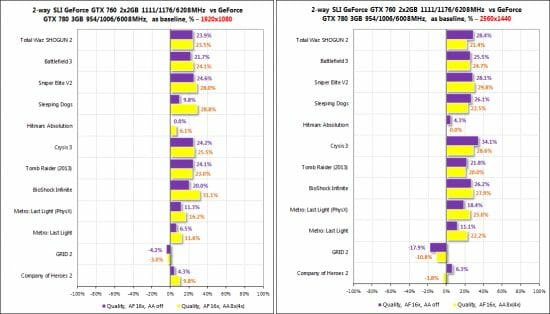
So, the two graphics cards which cost $100-150 less than the single GeForce GTX 780 beat the latter by 14-19% at 1920×1080 and by 17-18% at 2560×1440. The only exceptions are GRID 2 (where SLI isn’t very efficient) and, to some extent, Company of Heroes 2. Besides, the SLI tandem has a low bottom speed in Sniper Elite V2 and Hitman: Absolution, but overall 2-way SLI based on two GeForce GTX 760s looks a viable solution.
Conclusion
Besides examining three graphics cards in this review, we have also learned that two GeForce GTX 760s can be combined into a single subsystem to deliver the performance of a single GeForce GTX 780. Moreover, the 2-way SLI tandem is going to cost less while delivering higher average performance. The difference in price can save you enough money to buy a decent DDR3 memory kit, for example. Of course, as is always the case with multi-GPU configurations, it is important for the graphics drivers and the game engine to ensure proper SLI support. Otherwise, you may have low bottom speed and, consequently, poor playability. But SLI and CrossFireX work much better today than just a couple of years ago and keep on improving. It is now quite a good time to build a SLI configuration if you’ve been waiting for the right moment.
The MSI GeForce GTX 760 OC Gaming is undoubtedly the best of the three products we’ve tested today. It features a quiet and highly efficient cooler, a custom PCB with improved power system and premium components, high overclocking potential, stylish looks, and three operating modes which can be enabled with a single click using MSI Gaming App. On the downside is the unnecessary stiffness rib which blocks SLI connectors for stiff SLI bridges. It may also be difficult to disconnect power cables from that card. On the whole, the MSI GeForce GTX 760 OC Gaming is a perfect choice in the middle price category. Surprisingly, it costs even lower at $260 than the products from Palit and Zotac, which are far from exceptional.
The Palit GeForce GTX 760 JetStream and the Zotac GeForce GTX 760 AMP! Edition use the reference PCB design but have original coolers and increased GPU and memory frequencies. The Zotac has the highest clock rates, actually, but the difference in performance isn’t large even in comparison with the reference card from Nvidia, let alone the pre-overclocked versions from MSI and Palit. Zotac’s Dual Silencer is not a very good cooler in terms of performance and noiselessness. Palit’s cooler is more efficient and somewhat quieter, but cannot match MSI’s. It may be appreciated by modders, however, thanks to the nice-looking white highlighting of its fans. The Palit and Zotac cards come to retail at the same price of $320.
Hopefully, we will be able to test more versions of the highly interesting GeForce GTX 760 which are currently offered by ASUS, Gigabyte, EVGA and other brands.